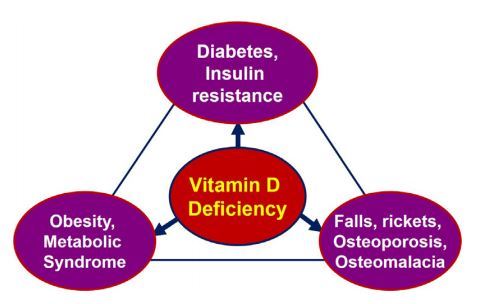Reasons to suspect Diabetes is related to low vitamin D
Associations of vitamin D with insulin resistance, obesity, type 2 diabetes, and metabolic syndrome
The Journal of Steroid Biochemistry and Molecular Biology, Vol 175, Jan 2018, Pages 177-189. https://doi.org/10.1016/j.jsbmb.2016.09.017
Sunil J.Wimalawansa MD, PhD, MBA, FRCP, FACP, FRCPath, Dsc (Professor of Medicine)

Highlights
Hypovitaminosis D: is inversely correlates with obesity and stroke.
Associate with increased CVD, myocardial infarction, diabetes, and mortality.
Associate with metabolic syndrome (hypertension, low HDL, and insulin resistance).
Sunscreen with greater than 12 sun protection factor (SPF), prevents generation of vitamin D.
Increased safe exposure to sun and consuming vitamin D-fortified foods are encouraged.
Supplements are necessary however, for those who cannot obtain adequate amounts.
Download the PDF from VitaminDWiki
The aim of this study is to determine the relationships of vitamin D with diabetes, insulin resistance obesity, and metabolic syndrome. Intra cellular vitamin D receptors and the 1-α hydroxylase enzyme are distributed ubiquitously in all tissues suggesting a multitude of functions of vitamin D. It plays an indirect but an important role in carbohydrate and lipid metabolism as reflected by its association with type 2 diabetes (T2D), metabolic syndrome, insulin secretion, insulin resistance, polycystic ovarian syndrome, and obesity. Peer-reviewed papers, related to the topic were extracted using key words, from PubMed, Medline, and other research databases. Correlations of vitamin D with diabetes, insulin resistance and metabolic syndrome were examined for this evidence-based review. In addition to the well-studied musculoskeletal effects, vitamin D decreases the insulin resistance, severity of T2D, prediabetes, metabolic syndrome, inflammation, and autoimmunity. Vitamin D exerts autocrine and paracrine effects such as direct intra-cellular effects via its receptors and the local production of 1,25(OH)2D3, especially in muscle and pancreatic β-cells. It also regulates calcium homeostasis and calcium flux through cell membranes, and activation of a cascade of key enzymes and cofactors associated with metabolic pathways. Cross-sectional, observational, and ecological studies reported inverse correlations between vitamin D status with hyperglycemia and glycemic control in patients with T2D, decrease the rate of conversion of prediabetes to diabetes, and obesity.
However, no firm conclusions can be drawn from current studies, because
(A) studies were underpowered;
(B) few were designed for glycemic outcomes,
(C) the minimum (or median) serum 25(OH) D levels achieved are not measured or reported;
(D) most did not report the use of diabetes medications;
(E) some trials used too little
(F) others used too large, unphysiological and infrequent doses of vitamin D; and
(G) relative paucity of rigorous clinical data on the effects of vitamin D sufficiency on non-calcium endpoints.
Although a large number of observational studies support improving T2D, insulin resistance, obesity, and metabolic syndrome with vitamin D adequacy, there is a lack of conclusive evidence from randomized control clinical trials that, these disorders are prevented following optimization of serum levels of 25(OH)D. However, none of the currently conducted clinical studies would resolve these issues. Thus, specifically designed, new clinical studies are needed to be conducted in well-defined populations, following normalizing the serum vitamin D levels in vitamin D deficient prediabetes subjects, to test the hypothesis that hypovitaminosis D worsens these disorders and correction would alleviate it.
Table 1 Relationships between vitamin D and diabetes
Scientific correlations between vitamin D and diabetes:
Beta-cells contain vitamin D receptors
1,25(OH)2D stimulates insulin release
Insulin “release” is reduced in vitamin D-deficient animals (and in humans)
1,25(OH)2D prevents development of diabetes in the NOD mouse
Recent meta-analyses show association of low vitamin D status with increased risk of BOTH type 1 and type 2 diabetes
Vitamin D and function of pancreatic b-cells:
Association between vitamin D and physiological functions of pancreatic b-cells
b-cells possess VDRs, and 1a-hydroxylase is expressed in pancreatic islet tissues
Vitamin D deficiency impairs glucose-mediated insulin release
Insulin secretion is calcium dependent and calcium homeostasis depends on vitamin D
Vitamin D supplements improve insulin release in response to oral glucose load and reduce free fatty acid levels
Vitamin D deficiency worsens diabetes:
Diabetes is 5 times more common in non-equatorial areas
Children getting 2000 IU of vitamin D are 8 times less likely to develop type 1 diabetes
Sedentary and obese people get less sun exposure and thus have less vitamin D
Worldwide, diabetes increases in parallel with vitamin D deficiency
Elderly and those with dark skin get 3-6 times less vitamin D from the same amount of sun exposure
Concerns related to clinical study data:
Lack of adequately powered, randomized controlled, clinical studies
Among the vitamin D intervention studies done, virtually none were designed for glycemic outcomes
Measurements of minimum (or median) serum 25(OH)D levels achieved were not reported;
Most did not report the use of diabetes (or even other) concomitant use of medications
Some trials used too little doses of vitamin D (e.g., <800 IU) above to bring serum vitamin D levels beyond 30ng/mL
Others studies used too large, unphysiological and infrequent doses of vitamin D that will not maintain serum 25(OH)D concentrations throughout the study period
Even the larger studies that are currently done are poorly designed to test vitamin D related hypotheses and hard endpoints
Relative paucity of rigorous clinical data on the effects of vitamin D sufficiency on non-calcium endpoints.
